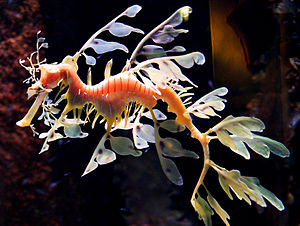Big shrimp fish
| Big shrimp fish | ||||||||||||
|---|---|---|---|---|---|---|---|---|---|---|---|---|

Great sea fish ( Phycodurus eques ) |
||||||||||||
| Systematics | ||||||||||||
|
||||||||||||
| Scientific name of the genus | ||||||||||||
| Phycodurus | ||||||||||||
| Gill , 1896 | ||||||||||||
| Scientific name of the species | ||||||||||||
| Phycodurus eques | ||||||||||||
| ( Günther , 1865) |
The Great Sea Dragon ( Phycodurus eques ) is a fish from the family of pipefish (Syngnathidae) and the only kind in the genus Phycodurus . It lives in the cooler waters on the south coast of Western Australia and South Australia at depths of 3 to 30 meters. It also occurs sporadically on the south coast of Victoria and on the south west coast of Western Australia. Its preferred habitat are rock reefs bordering on sandy areas, overgrown with brown algae , especially of the Ecklonia genus . Hence the scientific name: from (Greek) phykodes tang- like, ouros tail, and (Latin) eques rider.
features
The animals are characterized by a multitude of leaf-shaped outgrowths that camouflage them perfectly in their habitat. Specimens from shallow water are yellow or greenish in color, those from deeper regions tend to be dark brown to burgundy red. Large shredded fish grow to be 35 centimeters long.
nutrition
Like all pipefish , the great shrimp feed on small crustaceans, floating shrimp and shrimp. Larger specimens also eat various larger crabs, such as porcelain crabs .
Reproduction
Large shredded fish gather in shallow bays to mate in winter. The females can then be distinguished from the slender males by their heavily swollen bellies. The skin on the underside of the tail and sides of the tail of the males is now wrinkled, soft, and spongy to accommodate the 250 to 300 eggs laid by the females. The tail takes on a bright yellow color. During mating, the eggs are pressed into the skin of the tail, which then swells and hardens and forms a cup-like shape around each egg. The eggs are 7 mm long and 4 mm in diameter. After mating, many males migrate to deeper water. The fry hatch tail first, after about eight weeks in a period of six to seven days. They are then 3.5 cm long and can swim independently after three to six hours. Usually they then hike into shallower water from 5 to 7 meters deep.
Shrimp fish in aquariums
Large shredded fish are shown in show aquariums around the world. They are bred in South Australia and the offspring are exported. Shredded fish kept in aquariums can live up to ten years.
literature
- Rudie H. Kuiter: Seahorses, pipefish, shredded fish and their relatives , 2001, Verlag Eugen Ulmer, Stuttgart, ISBN 3-8001-3244-3
Individual evidence
- ↑ Archive link ( Memento of the original from April 12, 2012 in the Internet Archive ) Info: The archive link was inserted automatically and has not yet been checked. Please check the original and archive link according to the instructions and then remove this notice.
Web links
- Big Tornfish on Fishbase.org (English)
- Phycodurus eques in the endangered Red List species the IUCN 2008. Posted by: R. Connolly, 2006. Retrieved on January 2 of 2009.


